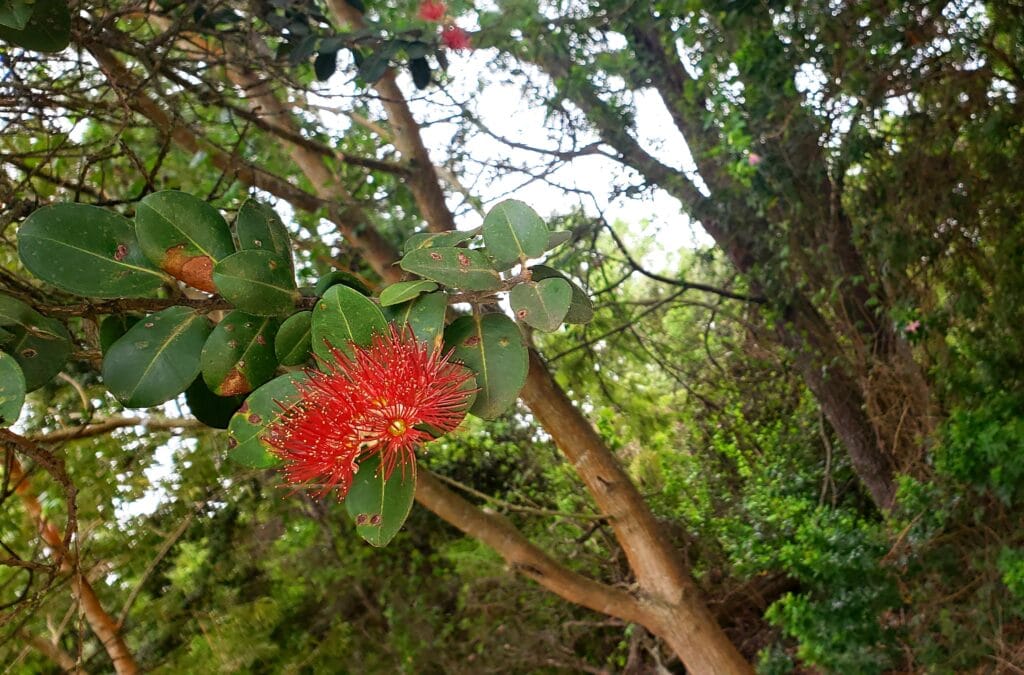April is Native Hawaiian Plant month and if you’re on a Big Island vacation, Hawaiʻi Volcanoes National Park is one of the best places to see and learn about these precious and beautiful trees, plants, and flowers that grow nowhere else in the world.
Before you visit, here’s a little background on Native Hawaiian plants!

Hawaiʻi is the most geographically-isolated populated landmass on the planet. As such, plants growing on the Hawaiian Islands evolved in their own unique way more than 70 million years ago. Today, you can find many of the descendents of those first colonizers dwelling in Hawaiʻi Volcanoes National Park.
Although all of these plants’ ancestors had defense mechanisms to survive, once they arrived in Hawaiʻi, it’s as if they realized that it was easier to get along and share their new island home than compete. The flora adapted to life without plant-eating mammals and learned to practice ecological aloha! You can even witness this remarkable phenomenon, called commensalism, happening in the park.
Literally meaning “eating at the same table,” commensalism is a relationship where one species benefits while the other is neither harmed nor benefits. For example, near the Visitor’s Center (which is undergoing renovations), stands an old growth koa tree that has ʻŌhiʻa Lehua growing out of it, as well as ʻōhelo kau la’au, native hāpuʻu pulu, moss, and even lichen growing on the top of it. And nothing is harming the koa as host! Hawaiʻi Volcanoes National Park has an array of these native Hawaiian plants, which are all vital to their forest home and sacred in Hawaiian culture.
Prominent in the park, the koa is a species of hardwood tree deeply rooted in Hawaiʻi’s history and culture. Hawaiians used koa wood to build canoes, surfboards, ukuleles, tools, and even weapons. Also a tree species, the ʻōhi’a lehua was one of the first flora to colonize new lava flows. Although its flowers can be a sunny orange or yellow, the ʻōhi’a lehua’s fiery red flowers are the most recognizable. You can find four varieties of ʻōhiʻa in Hawaiʻi Volcanoes National Park, all of which are connected to Pele, the volcano goddess. You can even see the ʻōhi’a lehua from the comfort of Tutu’s Place or the Ola House, as the cottages are tucked away on a village road, surrounded by a thick grove of the enchanted trees.
Like the koa, the ʻōhelo kau la’au (also called tree ʻōhelo) is a pioneer species known for colonizing new lava flows. Out of the three native species of this distinctive deciduous shrub that are found in Hawaiʻi, this one is the tallest. It can grow to more than 15 feet in height and be a minimum of six feet wide! Not to be outdone by a shrub, the native hāpuʻu pulu is an enormous tree fern that can reach up to 30 feet tall. Admired for pulu, or soft, golden fibers that adorn its fiddleheads and stalks, Hawaiians used the hāpuʻu’s pulu for stuffing mattresses and pillows, dressing wounds, and cultural practices.
Other Native Hawaiian plants like naupaka and ʻōlapa also thrive in Hawaiʻi Volcanoes National Park. Naupaka’s flowers appear to be split in half, inspiring an ancient Hawaiian legend about forbidden love represented by the naupaka kuahiwi (mountain naupaka) and naupaka kahakai (beach naupaka). The ʻōlapa is a tree with brown or even indigo, berry-like fruits that are an important food source for many Hawaiian honeycreeper birds. Traditionally, Native Hawaiians used the ʻōlapa’s bark and fruit to create dark-colored dyes. Look for this tree along Hawaiʻi Volcanoes National Park’s eastern boundary and near Nāhuku (Thurston Lava Tube).
April is the perfect time to celebrate the biodiversity and beauty of the nearly 1,400 native plant species found in Hawaiʻi. It’s also an opportunity to raise awareness about a concerning statistic: Over 200 of endemic Hawaiʻiʻs plant species have 50 or less plants remaining. Fortunately, we can all do our part to protect them! Here’s how:
- Leave plants in place! Removing native plants from the wild can be very harmful to the ecosystem.
- Stay on the trail when hiking in Hawaiʻi Volcanoes National Park. If you go off trail, you can put yourself and native Hawaiian species in danger by increasing the chances of spreading invasive species into the forest. You could also spread Rapid ʻŌhiʻa Death (ROD), a disease that’s deadly to ʻŌhiʻa Lehua.
Stay Near Hawaii Volcanoes National ParkReady to visit Hawaiʻi Volcanoes National Park? For the best lodging in Volcano Hawaiʻi, stay at a Volcano Village vacation rental just five minutes from the park… the Volcano Heritage Cottages! Tutu’s Place and the Ola House are only five minutes from the park, so book your Volcano Hawaii vacation home rental and grow some new memories you’ll cherish forever!
